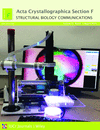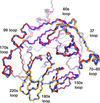issue contents
August 2019 issue

Cover illustration: An inexpensive automated microscope (AMi) that has been specifically designed for viewing and imaging the contents of multi-well plates, and is controlled through the dedicated software AMiGUI [Bohm (2019), Acta Cryst. F75, 531-536].
editorial
Free 

A new category of Acta Crystallographica F articles, Methods Communications, is introduced. The first of these to be published, describing an inexpensive crystallization imaging system, is discussed here. Readers are also reminded about another category of articles, Topical Reviews, which are now defined.
methods communications
Open  access
access
 access
accessDescribed here are instructions for building and using an inexpensive automated microscope that is driven by a dedicated graphical user interface. The system facilitates the automated imaging and manual inspection of multi-well plates.
research communications
Open  access
access
 access
accessThe isolation of the dominant isoform of haemoglobin from Atlantic cod caught in southwest Norway is reported and its X-ray crystal structure is presented.
PDB reference: cod haemoglobin, 6hit
Kallikrein-4 (KLK4) is a serine protease that is an attractive target for prostate cancer therapeutics. Here, the first crystal structure of catalytically active KLK4 in an uninhibited state is reported. The 1.64 Å resolution structure shows a canonical fold, but uses a nonstandard rotamer in a specificity-determining residue. This model will prove useful in understanding the subtle structural changes that are induced upon the binding of a ligand, and thus in the future structure-guided design of KLK4 inhibitors.
PDB reference: apo KLK4, 6nvb
The iMango-III aptamer demonstrates one of the largest fluorescence enhancements of all RNA aptamers. Here, the room-temperature crystal structure of the iMango-III aptamer determined using an X-ray free-electron laser is reported.
PDB reference: iMango-III, 6pq7
Open  access
access
 access
accessA 1.7 Å resolution co-crystal structure of U7BR from Schizosaccharomyces pombe in complex with Ubc7 is reported. Structural comparisons and biochemistry suggest that U7BR presents a steric impediment to E1 binding and inhibits E1-mediated charging, respectively.
PDB reference: Ubc7–U7BR complex, 6op8
Crystallization and structural analysis are reported of the Rel stringent factor from Thermus thermophilus in the resting state and bound to nucleotides.


 journal menu
journal menu



















![[publBio]](/logos/publbio.gif)





